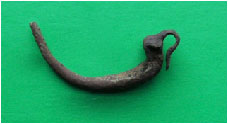It seems that people have lived in the Longtown area since the Stone Age. Flint tools were found at both excavation sites, as well as waste flakes showing that they were made locally.
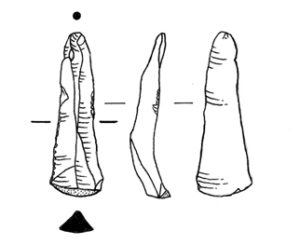
This fine pointed flint from Castle Green was probably used for making holes in wood or skins.
The two smaller flakes below from Ponthendre have been “retouched” to make concave scrapers perhaps for fashioning bone needles.
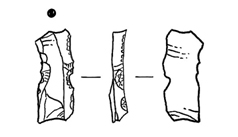
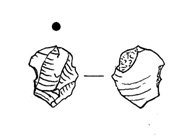
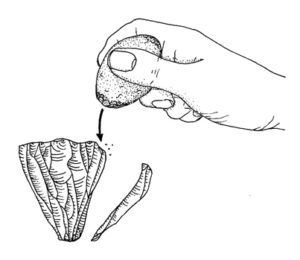 Thin flints like these can have razor-sharp edges and are called blades. Using a hammer stone, a large number of blades can be struck from a prepared flint core. The dots on the illustrations show the point of percussion. In Britain this technique began to be used at the start of the Neolithic period, 6000 years ago, but continued into the Bronze Age and sometimes even into the Iron Age in areas where flint was readily available.
Thin flints like these can have razor-sharp edges and are called blades. Using a hammer stone, a large number of blades can be struck from a prepared flint core. The dots on the illustrations show the point of percussion. In Britain this technique began to be used at the start of the Neolithic period, 6000 years ago, but continued into the Bronze Age and sometimes even into the Iron Age in areas where flint was readily available.
Flint isn’t found in Longtown’s sandstone geology, so the material for making these tools was brought in from elsewhere. Flint can be found as pebbles on beaches or in glacial deposits on the Welsh uplands, but most flint comes from the chalklands of southern and eastern Britain. This suggests that the early people of Longtown had extensive trading links across the country.
Bronze Age burials have been discovered in the Olchon Valley, including at the recently excavated cairn, 3 miles north-west of Longtown.
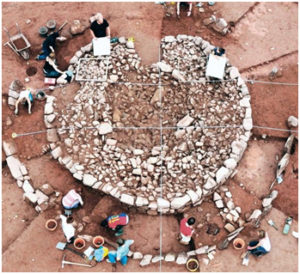
There are three Iron Age forts not far from Longtown – above Walterstone, at Pentwyn on the end of Hatterall Ridge and on the Skirrid. Not long ago, part of a 1st century Iron Age cloak pin was found in a field adjoining Longtown Castle.
